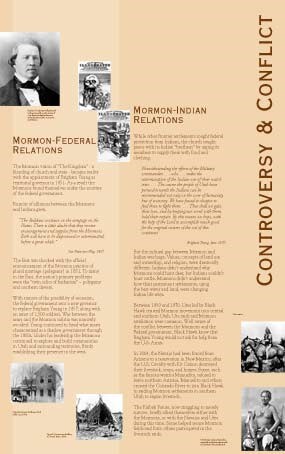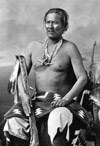
The Mormon vision of "The Kingdom" - a blending of church and state - became reality with the appointment of Brigham Young as territorial governor in 1851. As a result the Mormons found themselves under the scrutiny of the federal government. Rumors of alliances between the Mormons and Indians grew. The Redskins continue on the rampage on the Plains. There is little doubt that they receive encouragement and supplies from the Mormons. Both will have to be dispossessed or exterminated, before a great while. San Francisco Flag, 1867
The East was shocked with the official announcement of the Mormon practice of plural marriage (polygamy) in 1852. To many in the East, the nation's primary problems were the "twin relics of barbarism" - polygamy and southern slavery. With rumors of the possibility of secession, the federal government sent a new governor to replace Brigham Young in 1857, along with an army of 2,500 soldiers. War between the army and the Mormon militia was narrowly avoided. Young continued to head what many characterized as a shadow government through the 1860s. Under his leadership the Mormons continued to explore and build communities in Utah and surrounding territories, firmly establishing their presence in the west. | ||
|
Mormon-Indian Relations
| ||
|
While other frontier settlements sought federal protection from Indians, the church sought peace with its Indian "brethren" by urging its members to supply them with food and clothing. Notwithstanding the efforts of the military commanders . . . who . . . make the extermination of the Indian one of their watch cries....The course the people of Utah have persued towards the Indians can be recommended not only on the score of humanity, but of economy. We have found it cheaper to feed than to fight them....Thus shall we gain their love, and by keeping our word with them hold their respect. By this means we hope, with the help of the Lord to accomplish much good for the original owners of the soil of this continent. Brigham Young, June 1870
But the cultural gap between Mormon and Indian was huge. Values,concepts of land use and ownership, and religion, were drastically different. Indians didn't understand why Mormons could hunt deer, but Indians couldn't hunt cattle. Mormons didn't understand how their permanent settlements, using the best water and land, were changing Indians life ways. |
Between 1850 and 1870, Utes led by Black Hawk resisted the Mormon movement into central and southern Utah. Ute raids and Mormon retaliation were common. Well aware of the conflict between the Mormons and the Federal government, Black Hawk knew that Brigham Young would not ask for help from the U.S. Army. 
The Kaibab Paiute, now struggling to merely survive, briefly allied themselves either with the Mormons, or with the Navajos and Utes during this time. Some helped secure Mormon fields and forts; others participated in the livestock raids. | |
Last updated: March 31, 2012
